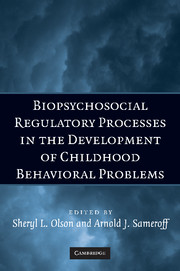Book contents
- Frontmatter
- Contents
- Preface
- Contributors
- 1 Conceptual Issues in Studying the Development of Self-Regulation
- 2 How Gene-Environment Interactions Can Influence the Development of Emotion Regulation in Rhesus Monkeys
- 3 Context Matters: Exploring Definitions of a Poorly Modulated Stress Response
- 4 An Integrative Approach to the Neurophysiology of Emotion Regulation: The Case of Social Withdrawal
- 5 Regulatory Competence and Early Disruptive Behavior Problems: The Role of Physiological Regulation
- 6 Behavior Regulation as a Product of Temperament and Environment
- 7 Self-Regulatory Processes in the Development of Disruptive Behavior Problems: The Preschool-to-School Transition
- 8 Emotional Dysregulation and the Development of Serious Misconduct
- 9 Regulatory Processes in Children's Coping with Exposure to Marital Conflict
- 10 Family Subsystems and Children's Self-Regulation
- 11 Culture and the Development of Regulatory Competence: Chinese–U.S. Comparisons
- 12 Self-Regulation and the Development of Behavioral and Emotional Problems: Toward an Integrative Conceptual and Translational Research Agenda
- Index
- References
5 - Regulatory Competence and Early Disruptive Behavior Problems: The Role of Physiological Regulation
Published online by Cambridge University Press: 02 July 2009
- Frontmatter
- Contents
- Preface
- Contributors
- 1 Conceptual Issues in Studying the Development of Self-Regulation
- 2 How Gene-Environment Interactions Can Influence the Development of Emotion Regulation in Rhesus Monkeys
- 3 Context Matters: Exploring Definitions of a Poorly Modulated Stress Response
- 4 An Integrative Approach to the Neurophysiology of Emotion Regulation: The Case of Social Withdrawal
- 5 Regulatory Competence and Early Disruptive Behavior Problems: The Role of Physiological Regulation
- 6 Behavior Regulation as a Product of Temperament and Environment
- 7 Self-Regulatory Processes in the Development of Disruptive Behavior Problems: The Preschool-to-School Transition
- 8 Emotional Dysregulation and the Development of Serious Misconduct
- 9 Regulatory Processes in Children's Coping with Exposure to Marital Conflict
- 10 Family Subsystems and Children's Self-Regulation
- 11 Culture and the Development of Regulatory Competence: Chinese–U.S. Comparisons
- 12 Self-Regulation and the Development of Behavioral and Emotional Problems: Toward an Integrative Conceptual and Translational Research Agenda
- Index
- References
Summary
OVERVIEW
Childhood externalizing behavior problems, including aggression, inattention, and defiance, have been the focus of considerable recent theoretical and empirical work (Broidy, Nagin, Tremblay, Bates, Brame, & Dodge, 2003; Campbell, 2002; Dodge & Pettit, 2003; Hinshaw, 2002; Moffit, 1993). This emphasis is due largely to the observation that such problems are moderately stable and predictive of other, more serious kinds of disorders in middle childhood (Olson, Bates, Sandy, & Schilling, 2002) and adolescence (Moffit, Caspi, Dickson, Silva, & Stanton, 1996). Risk factors for early behavior problems include child dispositional characteristics, such as temperament and biology (Bates, Pettit, Dodge, & Ridge, 1998; Hill, Degnan, Calkins, & Keane, 2006; Shaw, Gilliom, Ingoldsby, & Nagin, 2003); family factors, such as stress, psychopathology, and negative coercive behavior (Cummings, Davies, & Campbell, 2000); and contextual factors, such as social class, peers, school experiences, and neighborhoods (Coie, Terry, Lenox, Lochman, & Hyman, 1998; Dodge et al., 2003). Despite recent efforts to understand the trajectory of early disruptive behavior problems, much remains to be known about the mechanisms that maintain, ameliorate, or exacerbate such problems very early in development (Hinshaw, 2002).
- Type
- Chapter
- Information
- Biopsychosocial Regulatory Processes in the Development of Childhood Behavioral Problems , pp. 86 - 115Publisher: Cambridge University PressPrint publication year: 2009
References
- 16
- Cited by



